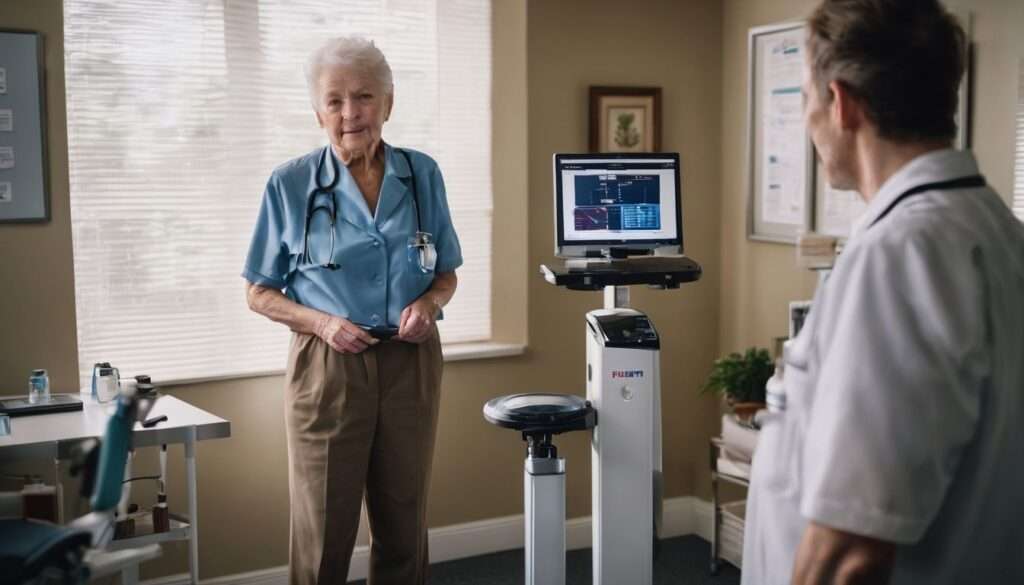Understanding BMI for the Elderly: A Comprehensive Guide to Healthy Aging
By Chantel Ilawole | Updated April 25, 2024
As we age, managing our weight becomes more complex, but understanding BMI can help. BMI, or Body Mass Index, is a tool that measures whether you’re in a healthy weight range for your height.
What is BMI?
BMI, or body mass index, is a measurement that helps determine an individual’s weight status based on their height. It is calculated by dividing a person’s weight in kilograms by the square of their height in meters.
Understanding BMI can help identify potential health risks related to being underweight or overweight.
Calculation and interpretation
To calculate BMI, you need your height in feet and inches and weight in pounds. Use these numbers with an Adult BMI Calculator if you’re 20 years or older. The calculator gives you a number that falls into one of four categories: underweight, healthy weight, overweight, or obesity.
This number shows if your weight could lead to health problems.
Your doctor can help you understand what your BMI means for your health. A normal weight range often leads to fewer health risks as you get older. If the BMI is too high or low, it may increase the chance of chronic conditions like heart disease or type 2 diabetes.
It’s best to check with a healthcare provider about what your specific BMI result means for you.
Risk factors for being overweight/underweight
Eating too much and not moving enough can lead to being overweight. This happens when you take in more calories than your body uses. Not exercising, eating lots of fast food, or being stressed can add to this problem.
Some medicines can also make you gain weight. Your genes play a role, too.
Being underweight can happen for different reasons. Not eating enough food is one reason. You might not feel like eating if you’re sick or sad. Having trouble getting food can also cause it.
Sometimes, your body burns up food too fast, like with hyperthyroidism or diabetes. Certain infections and diseases make it hard to keep on weight as well.
Differences in Measuring BMI for Adults and Elderly

As we age, our body composition changes, making it more challenging to accurately measure BMI for the elderly. These changes can affect how we interpret and understand BMI in older adults.
Changes in body composition with age
Our bodies change as we get older. Muscles may shrink, and fat can build up more easily. This happens even if we eat the same and stay active. Older adults often have less water in their bodies too, which can influence BMI and the assessment of overweight and obesity.
These changes can affect BMI because it’s harder to tell how much body fat someone has just by looking at their weight.
Measuring body composition gets tricky for older people. Their height might go down due to bones compressing over time. A lower height can raise BMI even if there’s no extra fat. It’s important to calculate your BMI to accurately determine health risks.
Also, being less muscular makes us burn fewer calories, which leads to gaining weight more easily. This means that keeping a healthy weight gets harder but is still important to avoid diseases like high blood pressure or diabetes mellitus type 2.
Now, let’s look into the difficulties in measuring BMI for elderly populations.
Challenges in measuring BMI for the elderly
- BMI calculators designed for adults may not account for the changes in body composition in the elderly.
- Elderly individuals may have difficulty providing accurate measurements of height and weight required for BMI calculation.
- The distribution of fat and lean body mass changes with age, affecting the accuracy of BMI interpretation.
- Existing BMI weight status categories may not reflect the specific health risks associated with excess weight in the elderly.
- Limited specific tools or resources are available to assist healthcare professionals in accurately measuring BMI for the elderly population.
Improving BMI for Elderly
Maintaining a healthy BMI is crucial for the elderly, and there are various ways to achieve or maintain a healthy BMI. Nutrition and exercise play a significant role in improving BMI for the elderly.
Importance of maintaining a healthy BMI for elderly
Maintaining a healthy BMI for elderly individuals is crucial for their overall health and well-being. Excess weight, particularly obesity, can increase the risk of chronic conditions like high blood pressure, type 2 diabetes, and high cholesterol.
By keeping a healthy BMI range, seniors can reduce their chances of developing these health problems and maintain better physical function as they age. Regular exercise, balanced nutrition, and monitoring BMI using a body mass index calculator are essential components in ensuring elderly individuals stay within a healthy weight range.
Improving the BMI of elderly people should be a priority as it serves as a reliable indicator of body fatness and helps to screen for potential health issues that may arise due to being underweight or overweight.
Ways to improve BMI
- Increase physical activity: Engage in activities like walking, swimming, or yoga to help maintain a healthy weight and improve overall health.
- Balanced diet: Consume a variety of nutrient-rich foods such as fruits, vegetables, whole grains, lean proteins, and low-fat dairy to support healthy aging and manage weight.
- Regular medical check-ups: Visit healthcare providers for routine check-ups to monitor weight changes and identify any underlying health issues that may affect BMI.
- Manage portion sizes: Control portion sizes to prevent overeating and maintain a balanced calorie intake suitable for individual needs.
- Stay hydrated: Drink an adequate amount of water daily to support metabolism and assist in regulating appetite.
Importance of nutrition and exercise
Maintaining a healthy BMI in later life requires attention to nutrition and regular exercise to avoid overweight and obesity. A balanced diet rich in fruits, vegetables, whole grains, lean proteins, and healthy fats supports weight management as well as overall health in the elderly.
Additionally, engaging in physical activity not only helps maintain a healthy BMI but also reduces the risk of chronic conditions like heart disease, type 2 diabetes, and osteoporosis.
Nutrition and exercise play pivotal roles in preventing age-related weight problems and improving BMI for the elderly. Moreover, these lifestyle choices are crucial for maintaining muscle mass while reducing body fat percentage.
Conclusion
In conclusion, understanding BMI for the elderly is crucial for assessing weight status and overall health. Measuring BMI in older adults requires consideration of their specific physiological changes, and using a BMI table can be helpful.
Improving BMI involves prioritizing nutrition and exercise to support healthy aging. Maintaining a healthy BMI can reduce the risk of chronic conditions such as high blood pressure and type 2 diabetes.
Embracing a balanced approach to managing BMI is essential for promoting well-being in older adults.
FAQs
1. What is BMI and why is it important for the elderly?
BMI stands for Body Mass Index, which is a screening measure used to assess an individual’s body weight in relation to their height. It helps determine if a person is underweight, normal weight, overweight, or obese, and is an important indicator of overall health. It’s important for the elderly because it can flag risks like malnutrition or obesity.
2. Can a high BMI indicate health problems in older adults?
Yes, a higher BMI in older adults may point to obesity-related diseases such as type 2 diabetes, coronary heart disease, and high blood pressure.
3. Is there a different BMI table for seniors?
While standard BMI tables exist, doctors might consider individual factors since an elderly person’s body composition changes over time.
4. How does muscle loss affect BMI in the elderly?
Muscle loss can lead to a leaner body mass in seniors; thus their BMI could underestimate the amount of body fat they have.
5. Are there other ways besides BMI to measure health risks related to weight?
Yes! Waist-to-hip ratio, waist-to-height ratio, and body shape index are also used to understand health risks better than just using traditional B.M.I tables alone.
6. How accurate is BMI in assessing body fat?
BMI is a screening measure and doesn’t directly measure body fat. It is used as a general indicator of health risks associated with abnormal body weight.
7. Why must healthcare providers be careful when interpreting an elder’s BMI?
Because an elder’s overall health involves more than just their weight – things like bone density, muscle mass, and overall nutrition need consideration too.

















